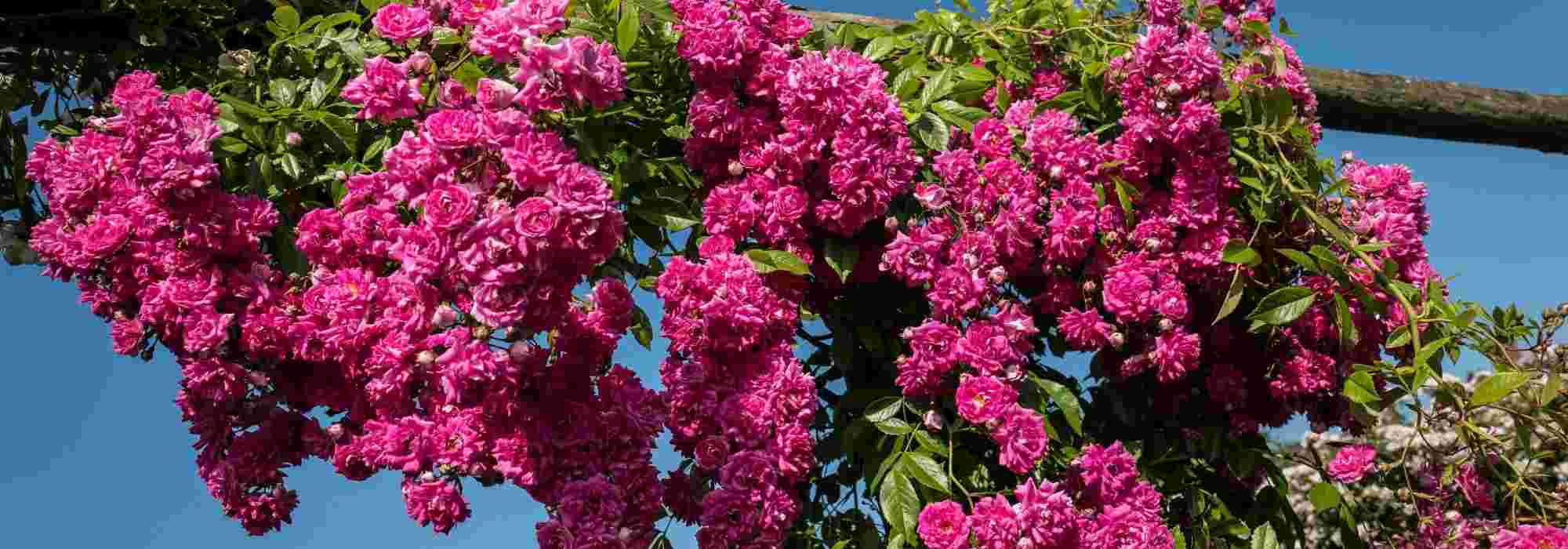
How to choose a rambling rose?
Buying guide and criteria to find the ideal rambling rose variety
Contents
Rambling roses differ from climbing roses: while both grow upwards and climb supports with their woody climbing stems, liana roses are more vigorous. They can reach heights of over 10 metres.
These roses are perfect for climbing into a tree, quickly covering a pergola, hiding an unsightly wall or structure, or even covering a bank.
A large, sturdy support will allow these highly floriferous roses to thrive without hindrance and become a stunning floral garland.
Follow our guide to find the liana rose suited to your desires and garden. Depending on their various characteristics (flower colour and shape, fragrance, foliage, hardiness, pruning,…), you will surely find the ideal liana rose.
And if you are still undecided, check out our selection of the 10 best varieties of rambling roses.
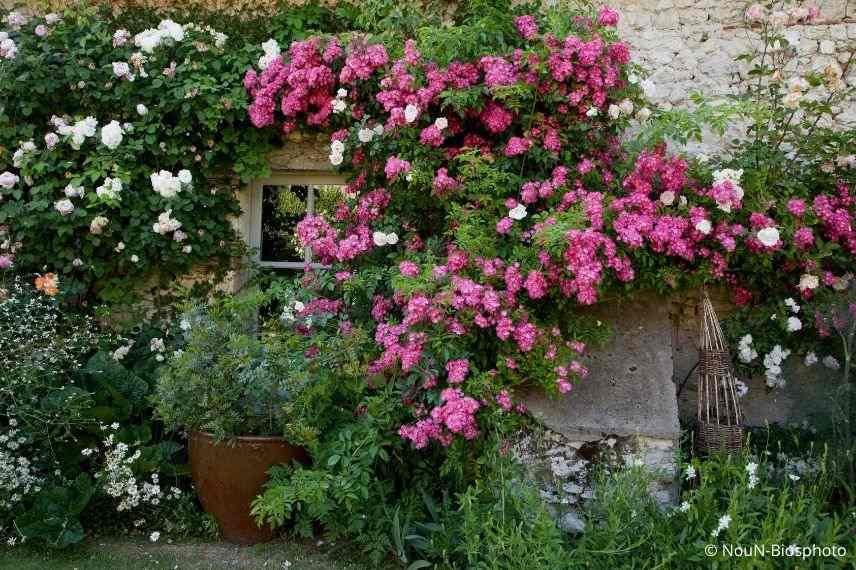
Rose ‘American Pillar’
Based on the colour of the flowers
The flowering of rambling roses is spectacular. Their natural floribundity rewards us with large clusters of flowers, revealing several shades of colour.
Pink rambling roses
Undoubtedly the most common roses, they instantly add a romantic touch to any garden. Pink flowering roses come in several shades, from the lightest to the most vibrant:
- the Banks rose ‘Rosea’ offers a bright pastel pink;
- the old rose ‘Albertine’ reveals a changing colour, shifting from a salmon pink to a carmine pink, then to a dragee pink;
- ‘Paul’s Himalayan Musk’ produces pink flowers in bright exposure, but rather white in partial shade;
- ‘American Pillar’ is adorned with a flamboyant bright pink, highlighted by a centre of yellow stamens;
- ‘Blush Rambler’ displays a fresh pink flowering that becomes pale, almost white.
White rambling roses
True symbols of English or romantic-inspired gardens, white roses bring a lot of brightness and lightness. They are also perfect for highlighting other colours:
- the Banks rose ‘Alba Plena’ and ‘Félicité et Perpétue’, with their cream-white pompom flowers;
- ‘Adélaïde d’Orléans’, with white roses tinged with pink, accented by a centre of golden stamens;
- ‘Seagull’, revealing white flowers with a yellow centre;
- the famous ‘Albéric Barbier’, with its flowering that starts as cream-yellow, then ivory white;
- ‘Wedding Day’ with white flowers that take on a pink hue before fading.
Yellow rambling roses
Yellow flowering roses bring a lot of warmth to the garden and pair very well with blue-violet flowers, or even a gradient shifting towards orange for an energetic touch.
Among them, the Banks rose ‘Lutea’ offers small butter-yellow pompons, while ‘Mermaid’ displays a sulphur yellow enhanced by vibrant stamens. Read our article on this wonderful rose: Banks Roses: discover these exuberant climbing roses!
Multicoloured rambling roses
For more original colours, opt for climbing roses that blend several shades.
This is the case with ’Kew Rambler’, which is adorned with flowers of a delicate soft pink, opening to a white centre from which golden stamens emerge.
On the other hand, ‘Veilchenblau’ produces roses of an uncommon violet-purple, revealing a white centre with yellow stamens. Before fading, the flowers take on a slightly bluish hue.
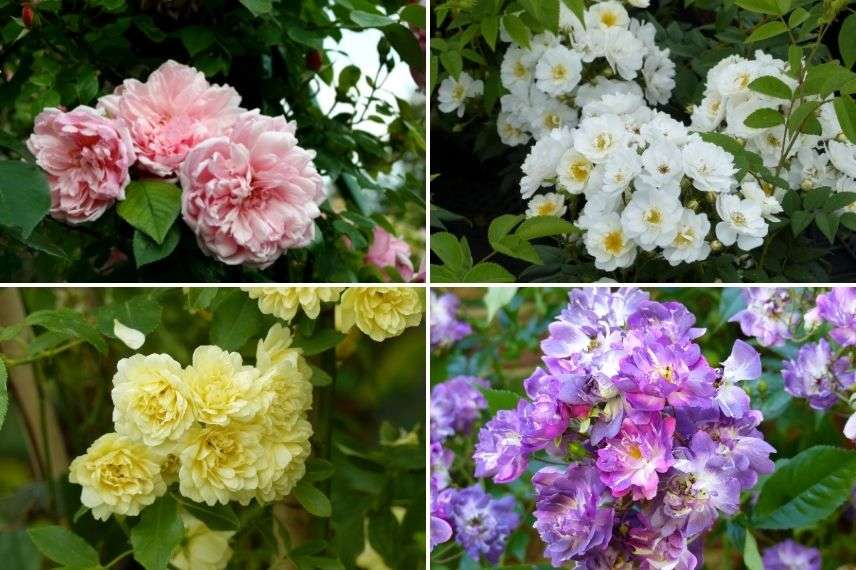
Above: Rosa wichuraiana ‘Albertine’ (photo Spedona) and Rose ‘Seagull’; below: Rosa banksiae ‘Lutea’ and Rosa wichuraiana ‘Veilchenblau’
According to the shape of the flowers
From single-stamen flowers to roses formed of multiple petals, the rambling rose offers a beautiful variety of flower shapes.
Rambling roses with single flowers
The vibrant ‘American Pillar’ and the delicate ‘Kew Rambler’ are part of these rambling roses with single flowers. They reveal single-row petal flowers, about 5 cm in diameter.
This is also true for ‘Kiftsgate’, which has slightly larger flowers measuring 7 cm.
Rambling roses with double flowers
‘Adélaïde d’Orléans’ offers semi-double flowers with several rows of petals, just like ‘Seagull’ and Veilchenblau.
Meanwhile, ‘Albertine’, ‘Albéric Barbier’ and ‘Seven Sisters Rose’ delight us with true floral pom-poms of abundant petals.
Rambling roses with large flowers
To admire the most impressive flowers of rambling roses, turn to the large-flowered roses, such as the sweet ‘May Queen’ with its 8 cm roses, or the delicate ‘Mermaid’ with its roses reaching 10 cm.
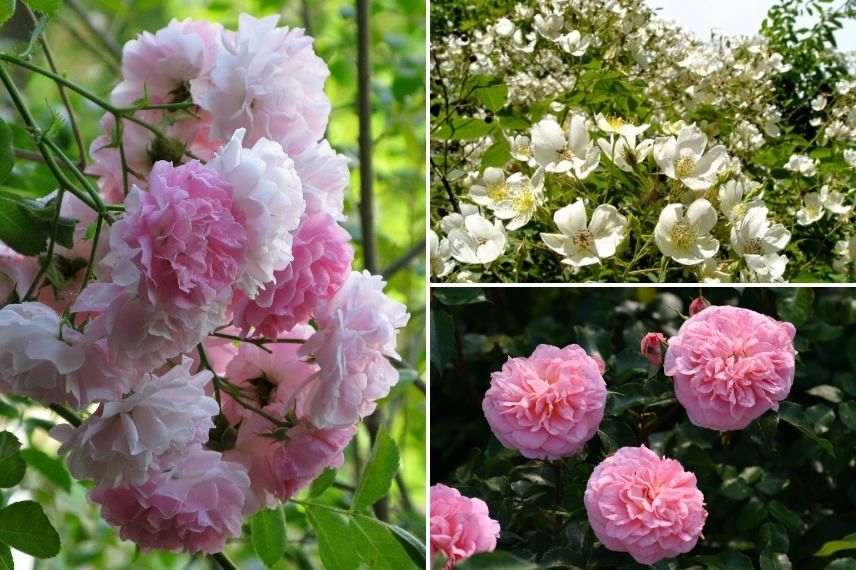
On the left: Rosa multiflora ‘Seven Sisters Rose’ with single flowers (photo Redagain Patti); on the right: Rosa filipes ‘Kiftsgate’ with double flowers (photo Wikipedia) and Rosa wichuraiana ‘May Queen’ with large flowers
Discover other Rambling Roses
View all →Available in 0 sizes
Available in 2 sizes
Available in 1 sizes
Available in 3 sizes
Available in 2 sizes
Available in 2 sizes
Available in 2 sizes
Depending on its fragrance
Rambling roses are generally fragrant plants. Some offer light fragrances, while others exude more powerful notes.
Among the most fragrant varieties, we find:
- ‘Albertine’, with a sweet, gourmand scent that is accentuated in hot, dry weather:
- ‘Rambling Rector’ or ‘Bobbie James’, with a powerful and surprising clove fragrance;
- ‘Wedding Day’, which exudes a honey scent;
- the Banks rose ‘Alba Plena’, with roses that emit a violet fragrance;
- ‘Paul Noel’, with an astonishing fragrance of apple and chrysanthemum;
- ‘Blush Rambler’ or ‘Paul’s Himalayan Musk’, which offer a very noticeable musky scent.
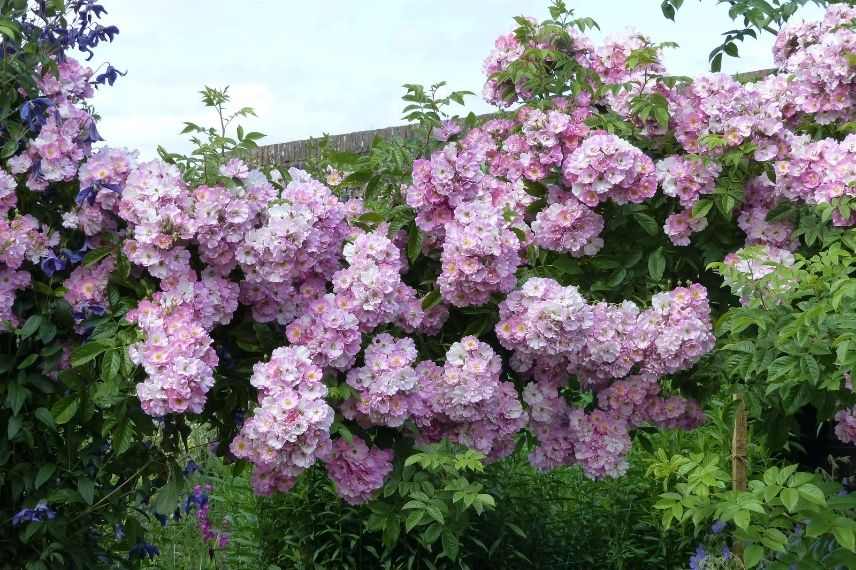
Rosa multiflora ‘Blush Rambler’
Read also
Caring for roses: the right equipmentAccording to the flowering period
Rambling roses usually flower only once a year, in spring or summer, during the months of May, June, or July. At this time, they offer a particularly abundant flowering for a true spectacle in the garden.
The Banks’ rose ‘Lutea’ treats us to an early flowering from the beginning of spring in April or May, lasting for nearly 3 weeks.
Adélaïde d’Orléans rewards us with a later flowering around mid-June, while ‘Kiftsgate’ only flowers in the heart of summer, in July.
While rambling roses are rarely perpetual, some cultivars offer a particularly long flowering period. For instance, the climbing rose ‘Aimée Vibert’ flowers from June until September, just like ‘Mermaid’, which extends its flowering until the first frosts.

Rosa noisette ‘Aimée Vibert’
The different sizes of rambling roses
Rambling roses are renowned for their large dimensions: they generally reach at least 4 metres at ripeness thanks to their flexible woody climbing stems. However, some varieties offer much more spectacular measurements, exceeding 10 metres.
These roses are thus perfect for covering large buildings or dressing tall trees. Obviously, they should be reserved for the largest spaces and extensive gardens, allowing them to showcase their full beauty.
Among the tallest, we can mention ‘Seagull’, ‘Wedding Day’ or ‘Rambling Rector’, with an average height of 8 metres. Meanwhile, the climbing rose filipes ‘Kiftsgate’ sends its stems up to 10 metres high.
The impressive Banks roses (‘Alba Plena’ or ‘Lutea’) can exceed 12 metres in height, with a spread of 4 to 6 metres.

Rosa filipes ‘Kiftsgate’
Thornless rambling roses
If you are looking for an inermous rose that won’t prick you while picking or pruning, consider the thornless varieties. They have few or no prickles at all.
This is the case, for example, with ‘Maria Lisa’, ‘Veilchenblau’, or Banks roses.
Semi-evergreen rambling roses
If rambling roses generally lose their foliage in autumn, some varieties can remain decorative for longer.
Their semi-evergreen foliage indeed stays in place relatively late in the season, depending on the regions.
This is the case with ‘Albéric Barbier’ with its glossy green foliage, the Banks rose ‘Rosea’ which can retain its foliage in winter, or ‘Alba Plena’ with its very lush and vibrant foliage.
Adélaïde d’Orléans also offers elegant, very dark, semi-evergreen foliage in most regions.
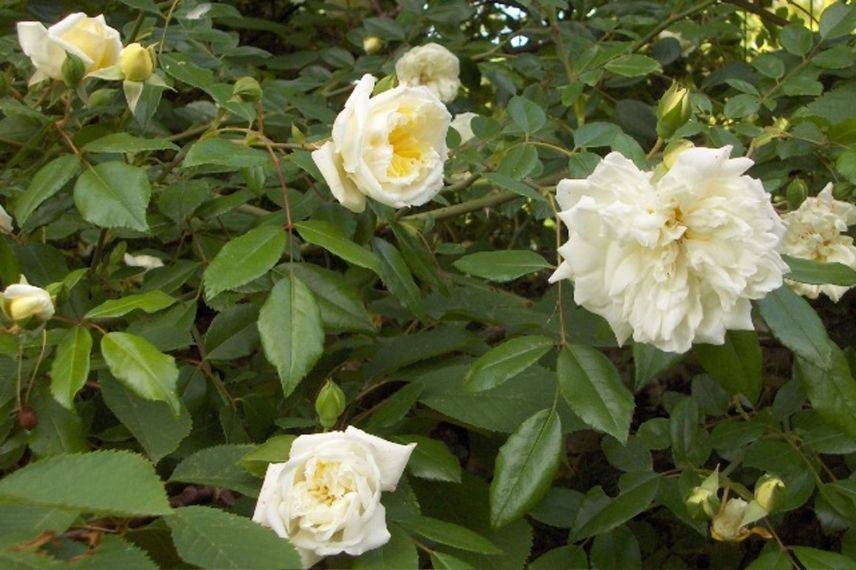
Rosa wichuriana ‘Albéric Barbier’
The most resilient rambling roses
The hardiest
Rambling roses are generally hardy. In regions with the harshest winters, choose cultivars that can withstand temperatures below -15°C, such as ‘Albertine’, ‘American Pillar’, ‘Blush Rambler’, ‘Bobbie James’, or ‘Aimée Vibert’.
Varieties resistant to diseases
Roses are susceptible to fungal diseases, such as powdery mildew, marsonia, or rust. These fungi can affect both the aesthetics and long-term health of the plant.
Fortunately, many varieties are now proving to be quite resistant, allowing for easier cultivation.
Generally, old roses tend to be more sensitive than modern hybrid varieties.
The Banks rose ‘Lutea’ has particularly healthy foliage, being less susceptible to diseases. While downy mildew may affect it in hot, dry conditions, it usually disappears spontaneously and quickly with the return of normal conditions.
‘Bobbie James’, ‘Cécile Brunner Clg’, or ‘Aimée Vibert’ are also among the disease-resistant rambling roses.
Drought-tolerant varieties
Banks roses cope well with summer drought and are suited to dry gardens: they will thrive in even poor, sandy soil, and can tolerate slightly calcareous conditions.
Rambling roses for shaded areas
While roses typically require sunlight for good flowering, some varieties can thrive even in shaded conditions. However, be aware that they will climb to seek out the sun!
This is true for ‘Mermaid’, ‘Paul Transon’, and ‘Paul Noel’, which tolerate shade well in warm climates.

The hardy Rosa multiflora ‘Bobbie James’ and Rosa wichurana ‘American Pillar’
- Subscribe!
- Contents
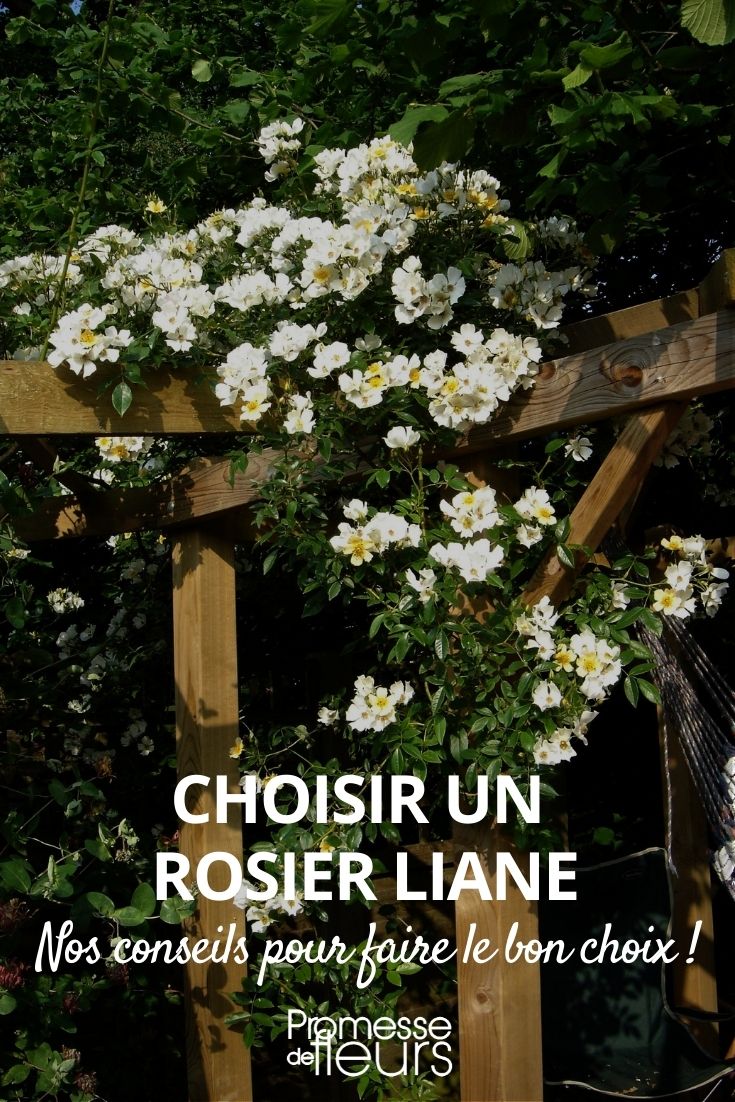































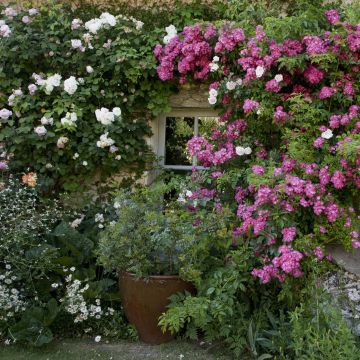
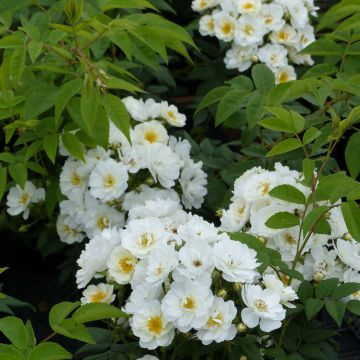
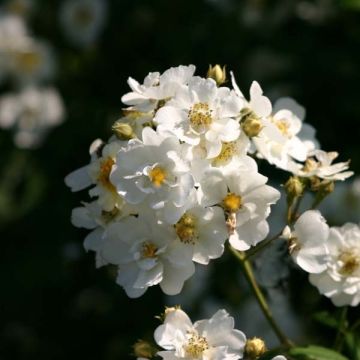
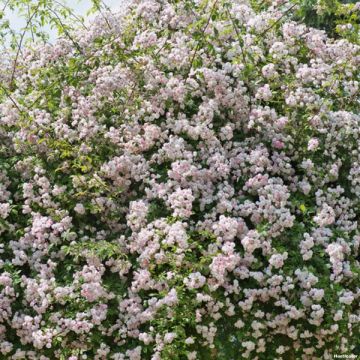
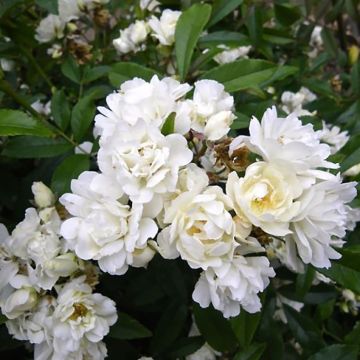
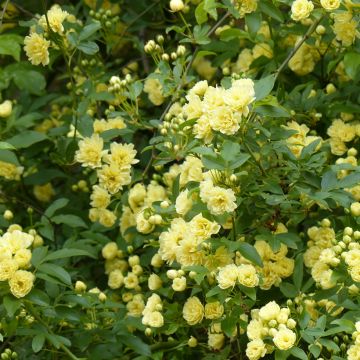
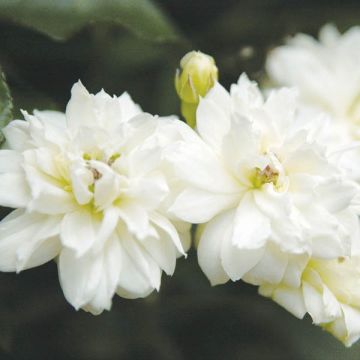
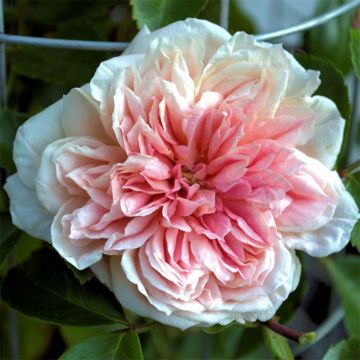
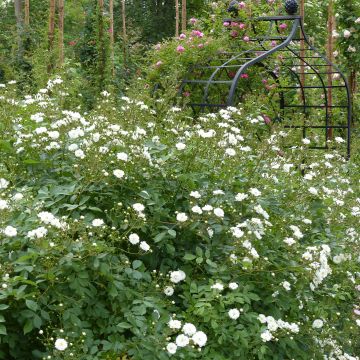
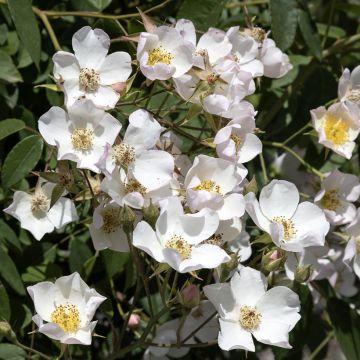
Comments